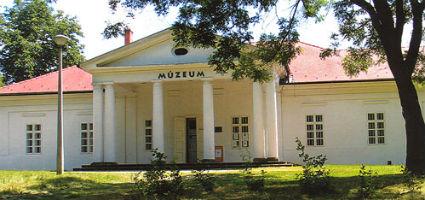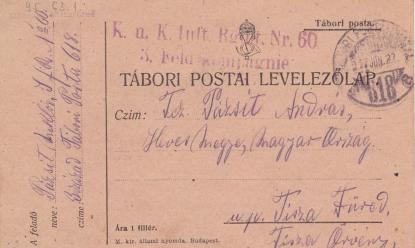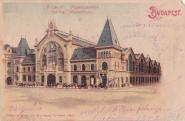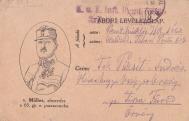2024. April 28. Sunday
Pál Kiss Museum - Tiszafüred
 |
Address: 5350, Tiszafüred Tariczky sétány 6.
Phone number: (59) 352-106
E-mail: kisspalmuz@gmail.com
Opening hours: Tue-Sat 9-12, 13-17
|
The exhibition has closed for visitors.
2014.08.04. - 2014.08.30.
Museum tickets, service costs:
|
Ticket for adults
|
500 HUF
|
/ capita
|
|
Group ticket for adults
(min. 10 people)
|
150 HUF
|
/ capita
|
|
Ticket for students
|
250 HUF
|
/ capita
|
|
Ticket for pensioners
|
250 HUF
|
/ capita
|
|
Ticket for families
(2 adults + max. 3 children)
|
750 HUF
|
/ family
|
|
Program ticket
|
300 HUF
|
/ capita
|
|
Season ticket
|
1000 HUF
|
|
|
Group guide
(max. 40 people)
|
2000 HUF
|
/ group
|
|
Photography
|
1000 HUF
|
|
|
Video
|
1000 HUF
|
During the World War I, millions of young men were sent to fight in the Great War, so millions of families were left behind without a son, without a brother or without a father. But the military camp postcards form an invisible bridge between the military front and the home. This month we show 24 field postcards from the World War I, sent by a Hungarian soldier from the war front home. He was Pázsit Miklós who lived in a small village called Örvény (it is next to Tiszafüred).

There are many types and forms of these cards, which can be divided by size, color or printing. There are different printings on the front sides of the postcards written by Hungarian, by German or by both: „Tábori postai levelezőlap”, „Feldpostkorrespondenzkarte”, „Tábori postai levelezőlap - Feldpostkorrespondenzkarte”, „Tábori levelezőlap”, „Feldpostkarte”, „Tábori levelezőlap Feldpostkorrespondezkarte”, „Levelező-lap - correspondenzkarte”. They were posted and stamped by military personnel at a military field post office. This stationary post office or a mobile one traveled with military units on the move in battle or maneuvers.
The paper is usually of one color, in this case pink, green or blue. These messages had a simple and common structure. What mattered was to receive/send a card with a dearly beloved name on it.
It started with the words „Dicsértessék a Jézus Krisztus” (Hungarian for: Praised be Jesus Christ) as the wtiter, the soldier was a Roman catholic by his religious. It was a traditional Roman Catholic greeting, which was commonly used.
Then the letter was continued with a very emotional apostrophe from the son to his Father and to his Mother, then to his Wife and to his little Son.
Then the son wrote that he was so thankful that God gave him a good luck and health and he wished the same to his beloved. Then there were only a few words about actual things (about the weather, about the letters or parcels what he had got a few days before, etc).
And came the ending of the letter. The soldier expressed his best wishes for the future of every beloved person. Then his name was on the paper. The final words were a farwell greeting as following: „Our God be with you, just as he is with us”.
By Vadász, István

There are many types and forms of these cards, which can be divided by size, color or printing. There are different printings on the front sides of the postcards written by Hungarian, by German or by both: „Tábori postai levelezőlap”, „Feldpostkorrespondenzkarte”, „Tábori postai levelezőlap - Feldpostkorrespondenzkarte”, „Tábori levelezőlap”, „Feldpostkarte”, „Tábori levelezőlap Feldpostkorrespondezkarte”, „Levelező-lap - correspondenzkarte”. They were posted and stamped by military personnel at a military field post office. This stationary post office or a mobile one traveled with military units on the move in battle or maneuvers.
The paper is usually of one color, in this case pink, green or blue. These messages had a simple and common structure. What mattered was to receive/send a card with a dearly beloved name on it.
It started with the words „Dicsértessék a Jézus Krisztus” (Hungarian for: Praised be Jesus Christ) as the wtiter, the soldier was a Roman catholic by his religious. It was a traditional Roman Catholic greeting, which was commonly used.
Then the letter was continued with a very emotional apostrophe from the son to his Father and to his Mother, then to his Wife and to his little Son.
Then the son wrote that he was so thankful that God gave him a good luck and health and he wished the same to his beloved. Then there were only a few words about actual things (about the weather, about the letters or parcels what he had got a few days before, etc).
And came the ending of the letter. The soldier expressed his best wishes for the future of every beloved person. Then his name was on the paper. The final words were a farwell greeting as following: „Our God be with you, just as he is with us”.
By Vadász, István


